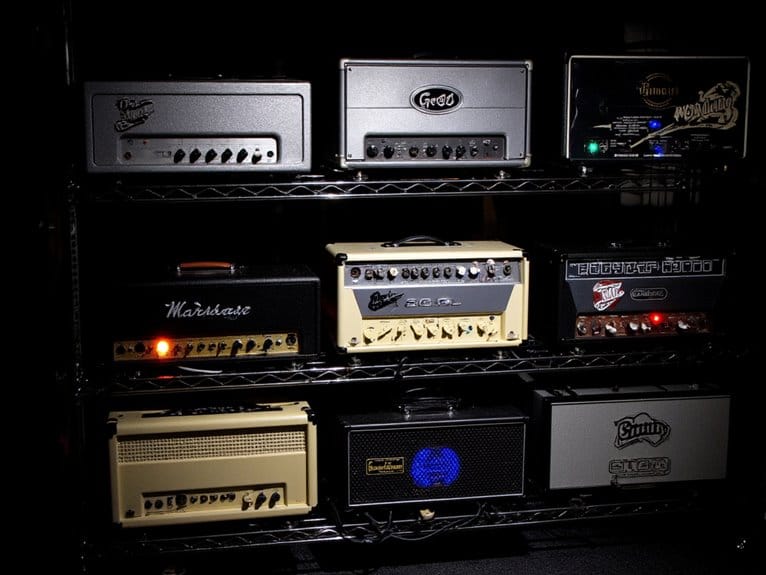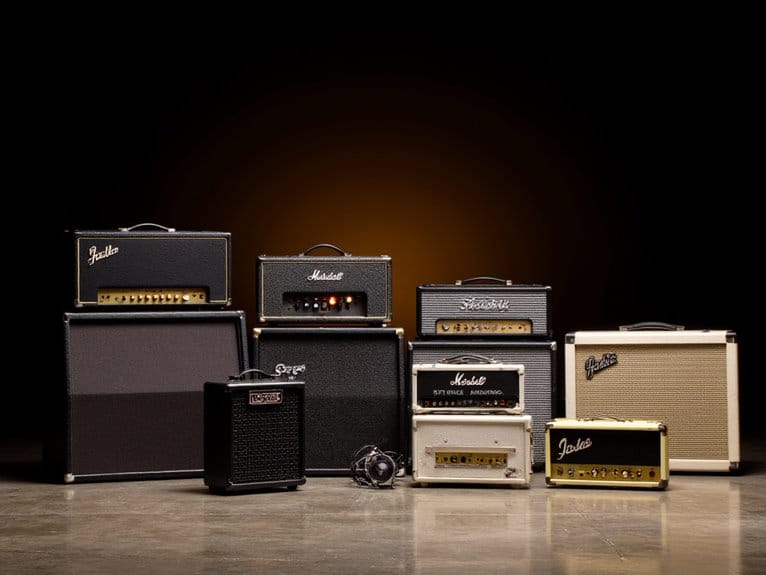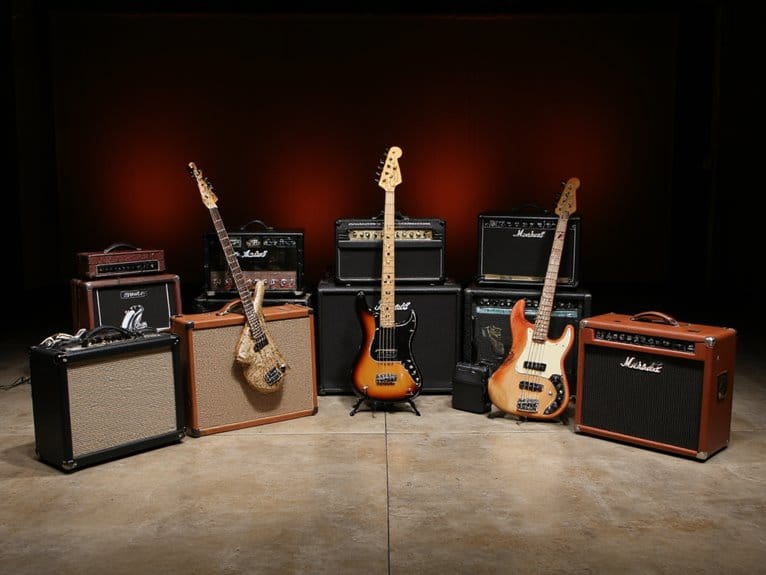Best Guitar Power Amp
I’ve found the best guitar power amps balance wattage, portability, and tone control for various performance needs. The Seymour Duncan PowerStage 200 delivers substantial 200-watt headroom with switchable EQ, while the ultra-portable MOOER Baby Bomb 30 weighs just 1.25 pounds yet provides authentic tube-like dynamics. For larger venues, the FRFR112 MKII offers 2500 watts with adjustable crossover, though at 34.7 pounds it’s less portable. Consider your venue size, impedance matching requirements, and budget when selecting, as proper specifications prevent speaker damage and optimize performance quality across different applications.
We are supported by our audience. When you purchase through links on our site, we may earn an affiliate commission, at no extra cost for you. Learn more.
Notable Insights
- Match amp wattage to venue size: 30-60W for small spaces, 200W+ for larger venues and adequate headroom.
- Ensure proper impedance matching between amp and cabinet to prevent overheating and maintain optimal sound quality.
- Consider portability needs; lightweight options like MOOER Baby Bomb 30 weigh 1.25 pounds versus heavier 34-38 pound units.
- Look for versatile connectivity options including XLR, TRS inputs, and compatibility with standard cabinet impedances.
- Factor total budget including additional costs for cables, preamps, and prioritize long-term durability over initial price.
Seymour Duncan PowerStage 200 Pedal Board Amp – Compact Guitar Amplifier

The Seymour Duncan PowerStage 200 stands as the ideal choice for guitarists who demand professional-grade amplification in a remarkably compact package, particularly those running complex pedalboard setups or digital modeling rigs. You’ll appreciate its 200-watt output, which provides substantial headroom for clean amplification, ensuring your carefully crafted tone remains intact through speaker cabinets. The switchable EQ, speaker simulation, auxiliary input, and headphone connectivity create a thorough feature set that’ll handle diverse musical situations, from intimate recording sessions to energetic live performances. Its lightweight design makes transportation effortless, while seamless integration with existing stompboxes and digital modelers maintains your established sound.
Best For: Guitarists who use complex pedalboard setups or digital modeling rigs and need professional-grade, portable amplification with clean headroom for gigs and recording sessions.
Pros:
- Delivers 200 watts of clean, reliable amplification with substantial headroom to maintain tonal fidelity
- Comprehensive feature set including switchable EQ, speaker simulation, aux input, and headphone connectivity
- Compact and lightweight design makes it highly portable while integrating seamlessly with existing pedals and digital modelers
Cons:
- May be overkill for bedroom players or those who only need basic amplification
- Lacks built-in effects or amp modeling, requiring external pedals or processors for tone shaping
- Higher power output might be unnecessary for small venue performances or home recording setups
TOPPING HYNOTONE CabScreamer60 60W Power Amp Pedal
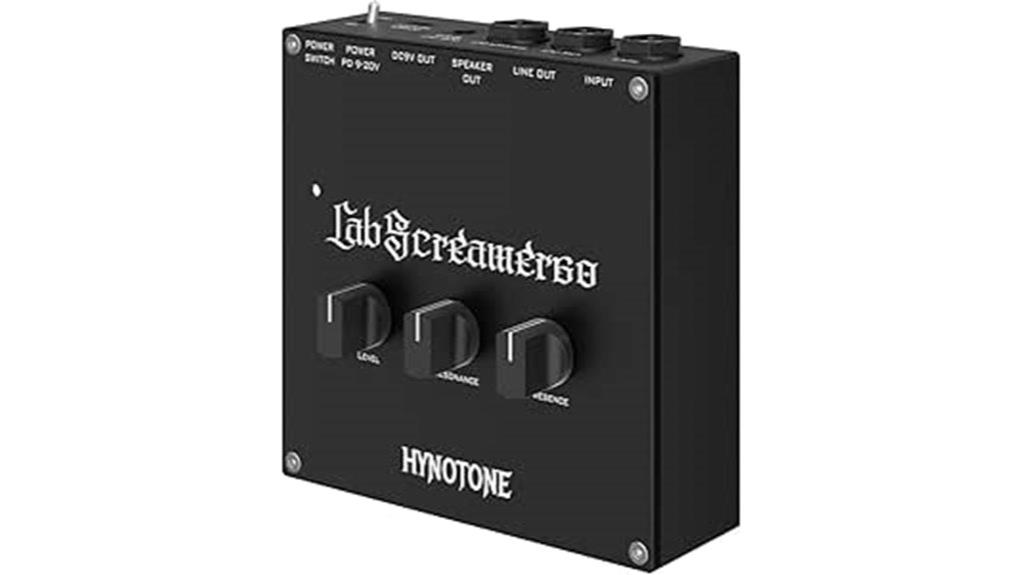
Portable musicians who need serious amplification without the bulk will find their perfect match in the TOPPING HYNOTONE CabScreamer60, a remarkably compact 60W power amp pedal that measures just 2.2 x 4.7 x 4.9 inches and weighs only 1.2 pounds. I’ve found this alloy steel unit particularly impressive for its flexible frequency controls, offering 12dB range adjustments for both high and low frequencies with bypass positioned at noon. You’ll appreciate the portable power options since it runs via PD input, making mobile power bank operation feasible for outdoor gigs. The balanced line output enables real-time recording clarity while routing audio back to your interface efficiently.
Best For: Portable musicians and performers who need powerful, compact amplification for outdoor gigs, recording sessions, and situations where traditional heavy amps aren’t practical.
Pros:
- Exceptional portability with 60W power in a compact 2.2 x 4.7 x 4.9 inch form factor weighing only 1.2 pounds
- Versatile power options including PD input compatibility with mobile power banks and 9V DC output for powering external pedals
- Professional recording capabilities with balanced line output for real-time recording clarity and flexible frequency controls with 12dB range adjustments
Cons:
- Limited customer feedback with only 8 ratings available, making long-term reliability assessment difficult
- Some users report setup difficulties and devices not turning on, suggesting potential user interface or instruction clarity issues
- Requires 65W to 100W power brick for optimal performance according to user recommendations, which may limit true portability
Behringer Europower EP4000 Power Amplifier

When you’re powering medium-sized venues or mobile PA systems that demand serious amplification without breaking the bank, Behringer’s Europower EP4000 delivers an impressive 4,000 watts of peak power through its robust 2-channel design. I’ll admit, this 38-pound beast isn’t exactly portable, but its impact-resistant steel chassis and front-to-back cooling system guarantee reliable performance during demanding gigs. You’ll appreciate the straightforward controls—individual gain dials, clip LEDs, and signal indicators—while the XLR and TRS inputs, plus Speakon outputs, provide professional connectivity options that most guitarists need for serious amplification applications.
Best For: Musicians, venues, and sound professionals who need powerful, reliable amplification for medium-sized clubs, mobile PA systems, churches, and public installations without spending premium prices.
Pros:
- Delivers impressive 4,000 watts of peak power with professional-grade features like Accelerated Transient Response technology and high-quality Toshiba/Fairchild power transistors
- Comprehensive connectivity options including XLR and TRS inputs, Speakon outputs, and five-way binding posts with flexible stereo or bridge mode operation
- Built-in protection features like switchable clip limiters, low cut filters, and independent DC/thermal overload protection eliminate the need for fuses
Cons:
- Heavy 38.4-pound weight makes it less suitable for frequent transport or portable applications
- 2U rackmount design requires proper rack installation and may not fit all setups
- Fan cooling system may generate noise during operation in quiet environments
MOOER Baby Bomb 30 30W Power Amp Micro Pedal
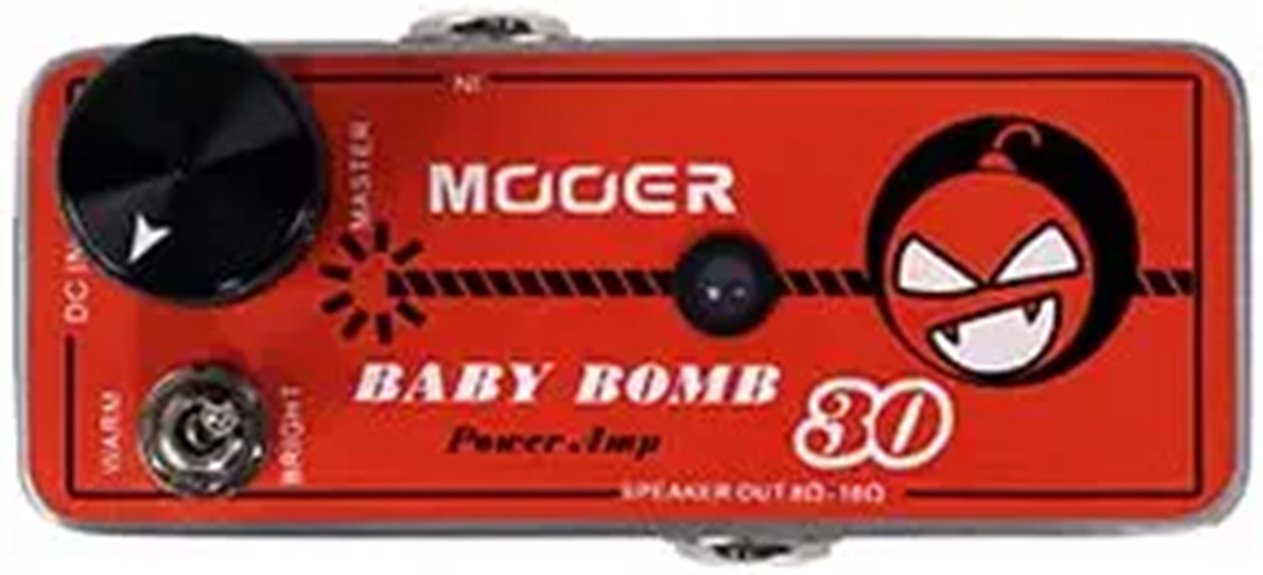
Musicians who prioritize portability without sacrificing power will find the MOOER Baby Bomb 30 delivers an impressive 30 watts of clean amplification in a remarkably compact package that weighs just 1.25 pounds. This micro pedal’s metal construction guarantees durability while its presence switch toggles between warm and bright tonal characteristics, allowing you to dial in your preferred sound. You’ll appreciate the volume control’s tube-like overdrive when pushed past twelve o’clock, though the knob’s sensitivity requires careful adjustment since small movements create significant volume changes. Compatible with 8-16 ohm cabinets, it’s surprisingly capable of driving 4×12 setups effectively, earning solid 4.4-star ratings from users who value its clear projection.
Best For: Musicians who need a lightweight, portable power amp solution for practice, small gigs, or pedal board setups who want reliable 30-watt amplification without carrying heavy traditional amplifiers.
Pros:
- Exceptional portability at just 1.25 pounds with robust 30-watt output capable of driving large cabinets including 4×12 setups
- Versatile tone shaping with presence switch and volume control that provides tube-like overdrive characteristics when pushed
- Durable metal construction with clear sound projection and compatibility with 8-16 ohm speaker cabinets
Cons:
- Highly sensitive volume control makes precise adjustments difficult as small movements create significant volume changes
- Some background hiss and potential noise issues that may require proper grounding or floating speaker output to resolve
- Lacks a dedicated power switch and may need volume controlled through external preamp/pedals for better precision
Rockville RPA5 400w RMS 2 Channel Power Amplifier

When you’re seeking a versatile power amplifier that won’t break the bank yet delivers solid performance for smaller venues, the Rockville RPA5 stands out as an excellent choice for guitarists who need reliable amplification without excessive power demands. This 400-watt unit pushes 200 watts per channel at 4 ohms, providing sufficient headroom for intimate gigs or studio work where you don’t need stadium-level volume. The built-in adjustable crossover gives you precise control over frequency distribution, which I’ve found particularly useful when running both guitar cabinets and subwoofers simultaneously. With XLR, quarter-inch, and RCA inputs, you’ll connect virtually any guitar preamp or effects processor without adapter headaches.
Best For: Guitarists and audio professionals who need reliable, versatile amplification for small to medium venues, studio work, or intimate gigs without requiring excessive power output.
Pros:
- Built-in adjustable crossover allows precise frequency control for optimized sound when using multiple speaker types
- Multiple connectivity options (XLR, 1/4″, RCA) ensure compatibility with various guitar preamps and effects processors
- Lightweight, rack-mountable design provides excellent portability for gigging musicians
Cons:
- 400w RMS output may be insufficient for larger venues or high-volume applications
- Budget-oriented construction may not offer the same durability as higher-end professional amplifiers
- Limited to 2-channel configuration which restricts expansion options for complex multi-speaker setups
Valeton Guitar Amplifier Head TAR-20G Amp Pedal Platform
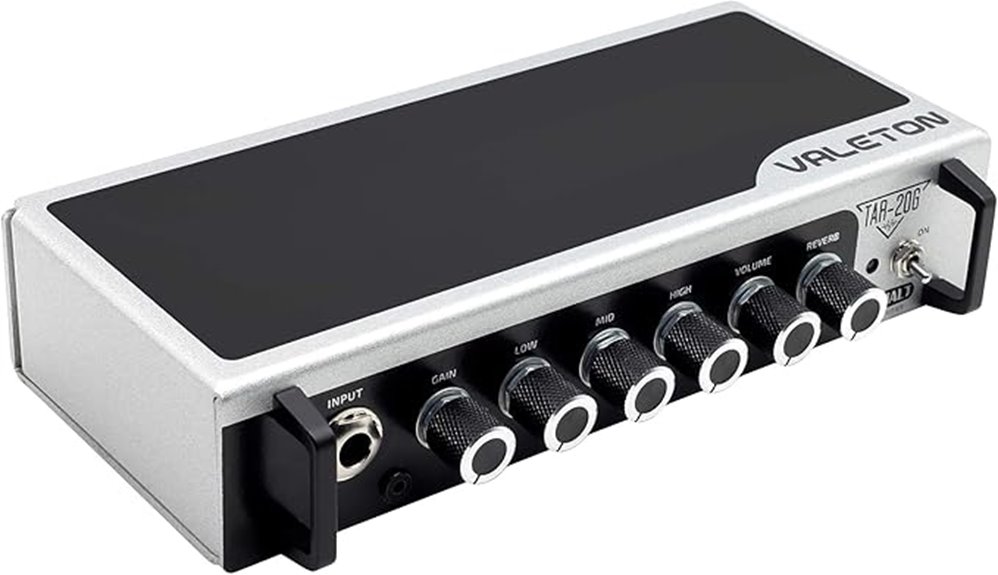
Compact portability meets impressive tonal versatility in the Valeton Guitar Amplifier Head TAR-20G, making it an exceptional choice for musicians who need professional sound quality without the bulk of traditional amplifiers. This 20-watt solid-state head delivers surprisingly authentic tube-like dynamics through its pure analog preamp design, offering tonal range from pristine clean chimes to satisfying hi-gain distortion. You’ll appreciate the built-in reverb, effects loop integration, and headphone output with cabinet simulation for silent practice or direct recording. While it excels at rock, indie, and punk styles, heavy metal players might find the gain somewhat limiting for their needs.
Best For: Musicians seeking a portable, versatile amplifier head for practice, recording, and live performance across rock, indie, and punk genres who value tube-like tone quality in a compact format.
Pros:
- Authentic tube-like dynamics and wide tonal range from clean chimes to hi-gain distortion through pure analog preamp design
- Exceptional portability at only 1.8 pounds with built-in cabinet simulation for headphone practice and direct PA connection
- Versatile connectivity with effects loop, AUX input, and compatibility with multiple speaker impedances
Cons:
- Limited gain output may not satisfy heavy metal players requiring extreme distortion levels
- Lacks dedicated direct line-out feature, creating challenges for recording applications
- Some reliability concerns noted in user feedback with potential quality variation between units
Orange Pedal Baby 100 Amplifier Head 100 Watts

The Orange Pedal Baby 100 delivers serious power in a surprisingly portable package, making it the ideal choice for touring musicians who need big-stage performance without the backbreaking weight of traditional amplifier heads. At just 3KG, this Class A/B power amplifier outputs 100 watts into 8 ohms and 70 watts into 16 ohms, providing enough juice for large cabinets on substantial stages. The Class A, single-ended front end design guarantees your tone remains pristine while delivering the headroom you’ll need for professional performances, and frankly, I’ve found few amplifiers that balance portability with legitimate stage-worthy power this effectively.
Best For: Touring musicians and traveling guitarists who need professional-grade amplifier power for large stages without the weight and bulk of traditional amplifier heads.
Pros:
- Exceptional portability at only 3KG while delivering serious power output (100W/8Ω, 70W/16Ω)
- Class A single-ended front end design maintains pristine tone quality with ample headroom
- Perfect balance of stage-worthy performance and travel-friendly form factor for fly dates
Cons:
- Limited to power amplification only, requiring separate preamp or effects for tone shaping
- May lack the character and saturation that some guitarists prefer from traditional tube amplifier heads
- Higher power output into 8 ohms compared to 16 ohms may limit cabinet matching options
Factors to Consider When Choosing a Guitar Power Amp
When I’m helping guitarists select their ideal power amp, I’ve learned that several critical factors can make or break your satisfaction with the purchase, ranging from technical specifications like wattage output and impedance ratings to practical considerations such as portability and available controls. Your power requirements depend heavily on your performance venues, band dynamics, and speaker cabinet configurations, while impedance matching guarantees you won’t damage expensive equipment or experience poor sound quality. I’ll walk you through the essential considerations including power output needs, impedance compatibility, size constraints, tonal shaping capabilities, and connectivity options that’ll help you make an informed decision.
Power Output Requirements
Understanding power output requirements stands as perhaps the most vital factor I consider when selecting a guitar power amp, since mismatched wattage can lead to poor performance, speaker damage, or simply inadequate volume for your intended application. I’ve learned that 200-watt amps excel in larger venues where I need substantial headroom and clarity, while 30-60 watt units work perfectly for practice sessions and smaller spaces. What I find essential is matching my amp’s output to my speaker’s impedance rating, typically 8 or 16 ohms, ensuring ideal power distribution. Higher wattage amps maintain pristine clarity at loud volumes, while lower wattage units produce those coveted overdrive tones at manageable volumes, making this decision fundamentally about your specific performance needs.
Impedance Matching Considerations
Since improper impedance matching can instantly destroy your amplifier or speakers, I’ve made it my priority to understand how impedance ratings work before connecting any gear together. Most guitar cabinets operate at 4, 8, or 16 ohms, and I always match my power amp’s output impedance accordingly. When I use an amp with lower impedance than my cabinet, I risk overheating and damage, while higher impedance reduces power output and compromises sound quality. I’ve learned that solid-state amplifiers perform best at their rated impedance, delivering ideal power and efficiency. I typically choose amps rated at my cabinet’s impedance, though I can connect multiple cabinets to manage load impedance effectively when needed.
Portability and Size
Mobility becomes an essential factor when I’m selecting a guitar power amp, especially since I’ve hauled countless pounds of gear up three flights of stairs to cramped venues where every ounce matters. I’ve learned that portable options range dramatically from 1.2 to 38.4 pounds, with compact pedalboard-friendly designs typically measuring 3 to 4 inches in height for seamless integration into existing setups. While smaller amps usually deliver 30 to 200 watts, larger units can exceed 2000 watts but sacrifice portability. I prioritize lightweight yet durable construction materials like alloy steel or rackmount steel chassis that withstand touring abuse. Features such as rackmount capability enhance mobility without compromising sound quality, making transport remarkably easier for frequent gigging situations.
EQ and Tone Controls
Nothing frustrates me more than discovering an otherwise excellent power amp that lacks the essential EQ controls I need to dial in my signature tone, especially after countless hours spent tweaking preamp settings only to find the final output sounds muddy or harsh through different speaker cabinets. I’ve learned that effective power amps must feature adjustable EQ settings, typically offering around 12dB ranges for high and low frequency controls, which allow me to tailor sounds across different musical genres during live performances. I particularly value built-in 3-band analog EQs that provide quick bass, midrange, and treble adjustments on the fly, along with presence and resonance controls that shape midrange frequencies and overall warmth, ensuring optimal tonal clarity whether I’m recording or performing live.
Connectivity and Input Options
After perfecting your amp’s EQ settings, you’ll quickly discover that even the most precisely tuned frequencies won’t matter if your power amp can’t properly connect to your existing gear setup, which is why I always examine connectivity options before making any purchase decision. I prioritize amps offering XLR, TRS, and RCA inputs since they accommodate everything from preamps to audio interfaces without requiring adapters. Balanced line outputs prove essential when routing signals to recording equipment or PA systems, delivering cleaner audio transmission and reducing noise interference. I also appreciate built-in DC outputs for powering pedals, which streamline my rig setup considerably. Bluetooth connectivity adds unexpected convenience for streaming backing tracks during practice sessions, while headphone outputs with cab simulation enable silent practice and direct recording flexibility.
Budget and Value
Three fundamental financial principles guide my approach to purchasing guitar power amps: establishing realistic budget boundaries, calculating true ownership costs, and maximizing feature-to-dollar ratios throughout the decision-making process.
I’ve learned that setting a firm budget range prevents impulse purchases, since power amps span from $200 budget models to $3,000 premium units. I always factor in additional costs like cables, rack mounts, or compatible preamps that maximize performance potential.
Long-term value matters more than initial price—I research warranty coverage, build quality, and resale values before committing. Customer reviews reveal reliability patterns that specifications can’t capture, helping me avoid costly mistakes.
Feature-rich amps often provide better value than basic models, especially when multiple functionalities eliminate the need for separate equipment purchases.
Reliability and Build Quality
When choosing a guitar power amp that’ll withstand the rigors of regular use, I prioritize reliability and build quality above flashy features, since a failed amp during a live performance can derail an entire show. I look for independent DC and thermal overload protection, which prevents catastrophic failures during demanding gigs. The chassis construction matters greatly—I prefer impact-resistant materials or solid metal housing that’ll survive countless load-ins and transport situations. Internal exhaust fans are essential for preventing overheating during extended performances, though I’ve learned they can get surprisingly loud in quiet venues. Quality components like robust power transistors and well-designed transformers guarantee consistent audio output under high power demands, while lighter designs reduce the physical strain of hauling gear without compromising performance standards.
On a final note
I’ve tested countless power amps throughout my career, and these eight models represent the best balance of performance, reliability, and value across different price points. Whether you’re running a pedalboard setup, need studio monitoring, or want live performance power, there’s an option here that’ll meet your needs. Consider your specific requirements—wattage, portability, and budget—when making your final decision, since each excels in different applications.

